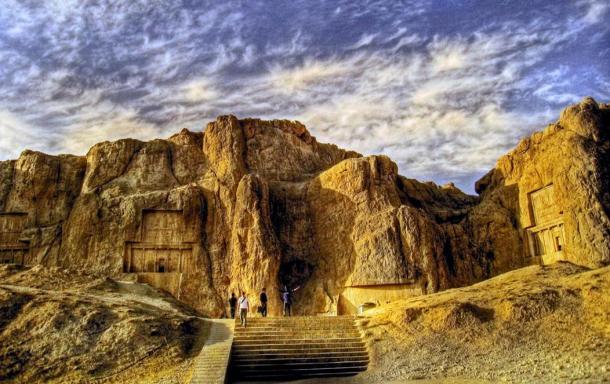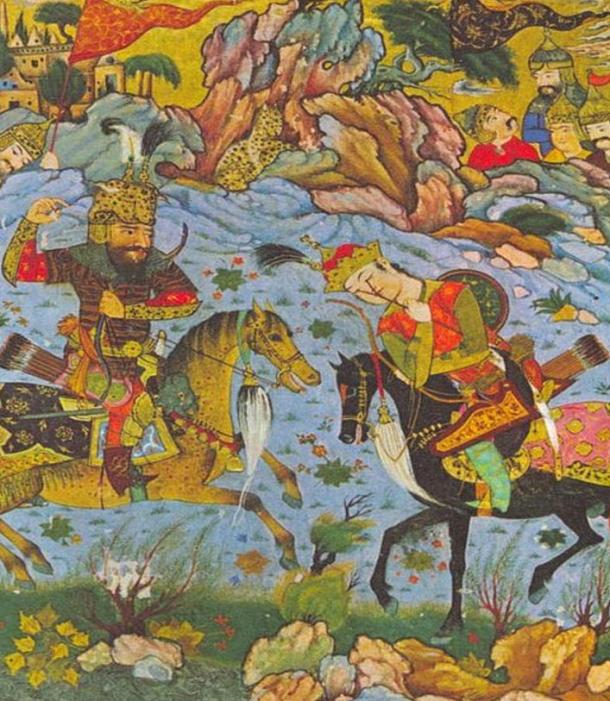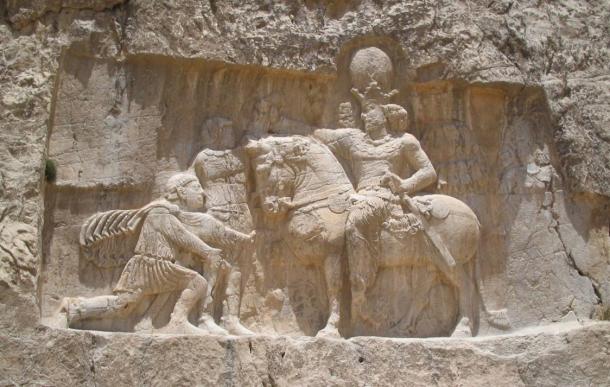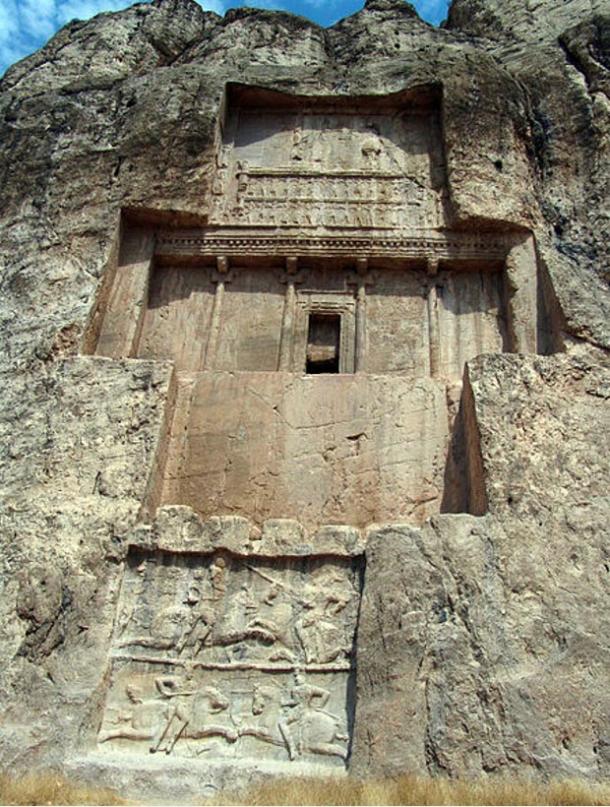Naqsh-e Rustam: Ancient Tombs of Powerful Persian Kings
(Read the article on one page)
Naqsh-e Rustam is one of the most spectacular and awe-inspiring ancient sites of the Achaemenid Empire, consisting of the colossal tombs of Persian kings dating back to the first millennium BC. It stands as a lasting memory of a once powerful empire that ruled over a significant portion of the ancient world.
Naqsh-e Rustam (meaning Throne of Rustam ) is located approximately 5 km (3 miles) to the northwest of Persepolis, the capital of the former Achaemenid (Persian) Empire. Engraved on the façade of a mountain range considered sacred in the Elamite periods are the rock-cut tombs of Achaemenid rulers and their families dating to the 4 th and 5 th centuries BC, as well as richly decorated reliefs carved by the Sasanians in the 3 rd century AD. In addition to being a royal necropolis, Naqsh-e Rustam became a major ceremonial center for the Sasanians until the 7 th century AD.

Naqsh-e Rustam at dawn ( Wikipedia)
The Naqsh-e Rustam site was already in use prior to the arrival of the Achaemenids, as evidenced in one pre-Achaemenid (possibly Elamite) relief and a number of old graves. Although this relief has been carved over by a Sasanian relief, a portrait of a man with a forward pointing hat and a long dress-like garment (clothing not typical of the Achaemenids and Sasanians) can still be discerned on the extreme right of the later relief. According to some sources, it was this figure that locals associated with the mythical hero of the Shahnameh writings in the “book of the kings”, named Rustam, hence the name of the site.

Naqsh-e Rustam is named after the legendary figure Rustam, who is depicted here killing Esfandyar. Medieval Persian miniature. ( en.wikipedia.org)
Most of the reliefs, however, date to beginning of the Sasanian period. In the 3 rd century AD, the Sasanians, a vassal of the Parthian Empire that succeeded in overthrowing its master, were a new power that rose in the East. In order to legitimize their rule, the Sasanians sought to associate themselves with the Achaemenid (Persian) Empire, and regarded themselves as its direct successors. One of the things they did to achieve this goal was to carve reliefs at Naqsh-e Rustam.

Sasanian relief at Naqsh-e Rustam depicting the triumph of Shapur I over the Roman Emperor Valerian, and Philip the Arab. ( Wikimedia Commons )
Two other local names for Naqsh-e Rustam are Salib, an Arabic word meaning ‘cross’, and the Persian Crosses. This is due to the façade of the tombs, which resembles crosses. It was the tombs, which belonged to the Achaemenids that attracted the Sasanians to Naqsh-e Rustam. These tombs are burial chambers carved into the side of the hill rock, and each contained a sarcophagus. It is unclear, however, whether the bodies were placed directly into these sarcophagi, or the bones interred in them after being exposed on a ‘tower of silence’. Furthermore, it is believed that all the tombs were looted and desecrated following the invasion of Alexander the Great during the 4 th century BC.
Although there are four tombs, only one of them can be identified with certainty, as it is accompanied by a trilingual inscription. This is the tomb of Darius I, the third ruler of the Achaemenid Empire. Above the cross façade of Darius’ tomb is a panel with a relief. The relief depicts Darius, whose hands are raised in a gesture of worship, standing on a three-stepped pedestal in front of an altar. The king’s piety accords him divine protection, as the winged disc of Ahuramazda (the god of the Zoroastrian faith), is shown floating above his head. The relief also proclaims the might of the Achaemenid Empire, as the entire scene is supported by throne bearers representing the 28 nations under the empire.

The tomb of Darius I at Naqsh-e Rustam ( Wikimedia Commons )
The other three tombs at Naqsh-e Rustam are thought to belong to Darius’ successors, Xerxes I, Artaxerxes I and Darius II. This is based on the fact that the layout of these tombs is copied from the tomb of Darius. Without any inscriptions or additional evidence, the identities of the tomb owners may remain merely as speculation. Other royal tombs of a similar form can be found in Persepolis. These tombs, cut into the rock face at Kuh-i Rahmat, are thought to belong to the later Achaemenid rulers, and demonstrate of the influence exerted by the tombs at Naqsh-e Rustam
|
+|نوشته شده در یکشنبه 96/1/27 ساعت 11:33 عصر توسط real iran
| نظر

Saadi Shirazi was born in Shiraz in 1200 or 1201.His father died when he was very young.Saadi Shirazi completed his primary education in Shiraz And later was sent to Baghdad for further education.At the Famous An-Nizamiyya college He studied Islamic Sciences,Law,History,Arabic Litrature and Islamic theology. Saadi Shirazi is widely recognized as one of the greatest authors of all times.He is not only known in Iran or Muslim countries,he has been quoted in western sources too.His best known work are "Bostan"Which was completed in 1257 and the "Gulistan" which was completed in 1258.
His work "Bostan" is consists of Stories Which represents the ethical lessons very beautiful.And speaks of justice,modesty,equality ect.These story are widely told in muslim countries,specially parents use them at bedtime for their children.
Gulistan is mainly in prose and contains stories,and at various places stories are given with beautiful poetry touch.you will find beautiful poems in "Gulistan".Along with many other Great poets of persian language his poems are the part of Pakistani curriculms for the students of persian language.Saadi shirazi"s work has a great influence on urdu language too.Urdu And persian are similar languages sharing the 42 percent of vocabulary.
There are scores of his poems which are very popular,i"ve choosen one for you,that goes like this,the poem is translated by M. Aryanpoor in English.
بنى آدم اعضای یک پیکرند
که در آفرینش ز یک گوهرند
چو عضوى به درد آورد روزگار
دگر عضوها را نماند قرار
تو کز محنت دیگران بی غمی
نشاید که نامت نهند آدمی
Human beings are members of a whole,
In creation of one essence and soul.
If one member is afflicted with pain,
Other members uneasy will remain.
If you"ve no sympathy for human pain,
The name of human you cannot retain!
I"ve designed some quotes of Saadi shirazi for his fans.These quotes are in the form of images.You will see the beauty of Saadi shirazi"s work in his quotes.Saadi shirazi"s books and his translations are available on internet easily for free.Read Saadi Shirazi quotes in English below..
Saadi Shirazi Quotes
If you cannot stand a sting,do not put your hand in scorpions nest.Saadi Shirazi
Reading is the best cure for grief and sadness |Saadi shirazi (May Allah be pleased with him)|
Do not be so strict that people hate you,and don"t be so polite that they attack you.Saadi Shiraz
|
+|نوشته شده در شنبه 96/1/26 ساعت 9:28 عصر توسط real iran
| نظر
Hello.Hafez is a great poet of Iran and world....you can know mor about him on this site:
http://www.iranonline.com/literature/hafez/life.html

|
+|نوشته شده در شنبه 96/1/19 ساعت 7:59 عصر توسط real iran
| نظر
Perspolis (Takht-e-Jamshid)
Perspolis is the name of one of the ancient cities of Iran that consistently over the years was the magnificent and ceremonial capital of Iran kingdom during the Achaemenid Empire.
In this ancient city there exists a building called Perspolis (Takht-e-Jamshid) which is constructed during the reign of Darius, Xerxes (New-Persian Khashayar, more currectly, khaš?y?rš?), and Artaxerxes I (Ardeshir I), and for about 50 years was the center for ritual ceremonies, especially Nowruz. The founder of this huge complex (Perspolis) was Darius the Great, most of the available information about the history and culture of the Acaemenid is due to the stone inscriptions which are engraved on the walls and tiles of the palace. The full extent of Perspolis (Takht-e-Jamshid) palaces is 125 thousand square meters.
At the time of construction the name of Perspolis was “P?r?a” meaning “the city of persian”. The Greek called it Perspolis (in Greek it means “Parse Shahr”). In contemporary Farsi this building is called Takht-e-Jamshid or the kingdom of Jamshid, the legendary king of Iran.
This complex has been recorded in the list of Iran’s Historical Works in the UNESCO Global Heritage from 1979.

The geographic location of Perspolis (takht-e-Jamshid)
Perspolis is located in the capital city of Fars province, 10 kilometers north of Marvdasht and 57 kilometers of Shiraz. Its height from above the sea level is 1770 meters.
In the East side of this complex palaces are leaning on Kuh-e-Rahmat (The mountain of Mercy), and other three parts are extended to the Marvdasht plain. Takht-e-Jamshid is built on Soffeh or a stone platform which is 8 to 18 meters above the Marvdasht plain. Dimensions of Takht-e-Jamshid are 445 meters (West), 300 meters (North), 430 meters (East), and 390 meters (South). Also, the length of Takht-e-Jamshid is equal to the length of Acropolis in Athens, but its width is four to five times the width of Acropolis.

Introduction to the oldest part of Perspolis (Takht-e-Jamshid)
Archaeological evidences show that the oldest parts of Perspolis date from 518 BC. As cited in various historical sources, the construction of Perspolis (akht-e-Jamshid) began about 25 centuries ago on the West hillside of Kuh-e-Rahmat (the mountain of mercy) or Mitrayamehr at the time of Darius the great and after that it has been continued by his successors with some alterations in its original building.
The construction of this huge and beautiful complex, according to some sources, lasted for 120 years.

Archaeological research
The first scientific excavations at Persepolis were carried out by the German Ernst Emil Herzfeld in 1931. He was sent by the Oriental institute of Chicago University. His findings are still being kept in this institute. Herzfeld believed that the reasons behind the construction of Perspolis were the need for a royal and majestic atmosphere, a symbol of the Empire and a place to celebrate special events, especially Nowruz. For historical reasons, Persepolis was built where the Persian Empire was founded, although it was not the center of the empire at that time.

The unique architecture of Perspolis
Architects, artists and professionals of the construction of Perspolis were from different nations under the reign of the Achaemenid kings such as Assyrians, Egyptians, Urartuians, Babylonians, Ludians, Ionians, Hindu, Scythians, and etc.
Over time a number of the pillars of the gate of Sad Sotun palace in Perspolis survived catastrophes such as earthquakes. At first glance they seem to be integrated, but in fact they are fragmented and are mounted on each other.
The secret behind their stability against earthquake is in the joint part of these fragments, where two pieces of pillars are joined together by the use of molten lead. In addition to strengthening the joint of the two pillars, this lead has a vital role in resistance of the structure against earthquake.
Lead is a malleable and soft metal that at the time of earthquake reacts and does not split, and this is the same role which is played by the springs put between the pillars in the modern buildings.

Persepolitan architecture is noted for its use of wooden columns. Architects resorted to stone only when the largest cedars of Lebanon or teak trees of India did not fulfill the required sizes to bear the cieling. Column bases and capitals were made of stone.
One of the architectural arts in Takht-e-Jamshid is that the ratio of portals’ height to their width and ratio of pillars’ height to the distance between the two pillars are golden ratios. Golden Ratio is important ratio in Geometry that exists in the nature. This shows the art of traditional Iranians is Architecture.
Arrangement of the motifs
Architectures and artists involved in the construction of Perspolis decorated the patterns and motifs in three ways.
One of them was sticking precious metals on the surface of the crown, earring, necklace, bracelet, and the like to the original pattern by the use of the holes which were made on both sides of the desired object to enjewel them.
Second designing and engraving the original ornaments of the clothes, crown and hats with needle, in a very delicate way, and there are some samples of them in the palaces of Darius (Tachara) and harems. Third is the coloring, of which there are samples in Se dar palace and Sad sotoon.
Introduction to palaces and buildings of Takht-e-Jamshid complex
Apadana palace
- Tachara palace
- Hadish palace
- Malakeh palace
- H palace
- Se dar palace
- Sad-sotoon palace
- Shoura palace (council palace)
- Tombs of the kings
- Imperial treasury building
Address: Perspolis (Takht-e-Jamshid), 57 Km of Isfehan _ Shiraz road, Shiraz, Fars province, Iran
for more information you can go http://www.untoldiran.com
|
+|نوشته شده در پنج شنبه 96/1/17 ساعت 3:49 عصر توسط real iran
| نظر















